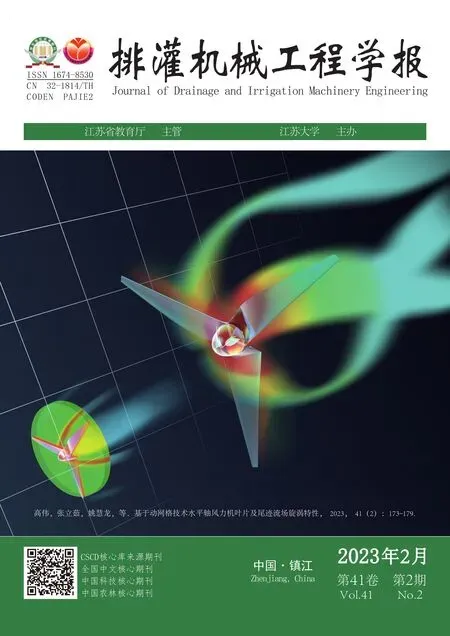Effects of water and nitrogen conditions under surge-root irrigation on growth yield of apple trees
, , , U , , ,
(1. Institute of Water Resources and Hydroelectric Engineering, Xi′an University of Technology, Xi′an, Shaanxi 710048, China; 2. Shaanxi Provincial Land Engineering Construction Group, Land Survey Planning and Design Institute, Xi′an, Shaanxi 710064, China; 3. Rural Revitalization Planning and Development Guidance Center of Yulin, Yulin, Shaanxi 719000, China)
Abstract: In order to explore the effects of different irrigation and nitrogen application on growth cha-racteristics and yield of apple trees under surge-root irrigation in mountainous areas of northern Shaanxi, field experiments were carried out with different apple trees. Three irrigation levels were applied: 85%-100% (H1), 70%-85% (H2) and 55%-70% (H3) of the field water capacity, respectively, and three nitrogen levels were N1 (360 g/plant), N2 (240 g/plant) and N3 (120 g/plant). The results show that irrigation and nitrogen application has significant effects on new shoot length, flowering and fruit setting, fruit diameter, fruit volume and yield of apple. The leaf area index (LAI) shows a single trend during the growth period, and the peak value appears in the middle of July. Under the same irrigation level, compared with N3, N1 increases in yield, new shoot length, LAI, transverse diameter, longitudinal diameter, volume, flowering and fruit setting by 17.91%, 28.31%, 18.75%, 11.38%, 10.13%, 36.60%, 20.92% and 5.19%, respectively, while N2 also increases by 12.40%, 15.63%, 4.86%, 5.40%, 5.11%, 17.01%, 26.17% and 13.74%, respectively. The rate of flowering and fruit setting decreases with the increase of nitrogen application. Under the same nitrogen level, compared with H3, H1 increases in yield, new shoot length, LAI, transverse diameter, longitudinal diameter, volume, flowering and fruit setting by 34.65%, 15.49%, 30.77%, 3.93%, 4.95%, 12.86%, 33.15% and 28.62%, respectively, while H2 also increases by 33.67%, 16.42%, 67.52%, 3.81%, 2.97%, 11.57%, 43.45% and 27.26%, respectively. The rate of flowering and fruit setting decreases first and then increases with the increase of irrigation amount. Compared with H3N3, the yield of other treatments increases by 2.69%-52.20%, while H2N1 treatment has the highest yield (26 852.55 kg/ha). Considering from the point of view of promoting growth and increasing yield, the best water and nitrogen combination mode of mountain apple in northern Shaanxi is medium water deficit irrigation and high nitrogen (H2N1) treatment. The results from this study can provide a theoretical basis for apple water and nitrogen management in mountainous areas of northern Shaanxi.
Key words: mountain apple;surge-root irrigation;irrigation;nitrogen;growth;yield
In 2019,apple planting area in Shaanxi province was 6.15×105hm2, and the yield was 1.14×1010kg, accounting for 31.6% and 26.2% of the total apple production in China, respectively[1]. The Loess Plateau is one of the main apple producing areas, but the area lacks water, has a amount of evaporation, and poor irrigation conditions[2], resulting in a prominent contradiction between water supply and demand in the orchard. At the same time, the local farmers are random and blind in fertilization. Therefore, it is of great signifi-cance to formulate water and fertilizer management stra-tegy in apple orchard.
Surge-root irrigation (SRI) is a local underg-round water-saving irrigation technology that directly applies water and fertilizer to crop roots. It has the advantages of water-saving, increasing yield and reducing soil evaporation[3]. Previous studies have shown that appropriate water deficit under SRI could inhibit the growth of new shoot, which was conducive to the formation of fruits[2]. At the same time, crop yield could be kept unchanged, achieving the purpose of stable yield and water saving[4]. With the increase of irrigation amount, the new shoot length and leaf area index (LAI) of apple trees increased first and then decreased[5]. Excessive water deficit would reduce the leaf water andLAIof crops[6]. Nitrogen was one of the main nutrients for crop growth, which could provide enough nutrients to improve crop growth and yield[7]. Studies found that increasing application of nitrogen could increase the growth rate of apple fruits and prolong the growth period of the fruits, increase the weight of each fruit to increase the yield[8]. The lack of nitrogen would lead to a decrease of the effective leaf area and reduce photosynthetic product[9].
Water and nitrogen are two important factors to promote crop growth and increase yield[10]. LIANG et al.[11]presented that apple yield was positively correla-ted with the amount of irrigation water and fertilizer, and the amount of fertilization had a greater effect on apple yield than irrigation. DAI et al.[12]found that the coupling effect of water and nitrogen had a significant effect on theLAIof apple trees. In addition, the treatment of high fertilizer and mild water deficit in the early growth period was conducive to the increase ofLAIof young trees[13].
At present, scholars at home and abroad have studied the coupling effect of water and fertilizer on fruit trees under different micro-irrigation techniques. However, there are few reports on the effect of water and nitrogen coupling on the growth characteristics and yield in mountainous areas of northern Shaanxi under SRI. Therefore, this study took the mountainous apple of northern Shaanxi as the research object, and studied the effects of different water and nitrogen combinations on the growth and yield of the mountainous apple of northern Shaanxi to find the best water and nitrogen combination mode for apples in the mountainous areas of northern Shaanxi under the SRI, and provide a theoretical basis for the reasonable water and nitrogen ma-nagement for local orchards.
1 Materials and methods
1.1 Experimental location and growth conditions
The experiment was conducted from April to October 2019 at a commercial apple orchard located in Qingshuigou Village, Zizhou County, Yulin City, Shaanxi Province, Northwest China (110°2′E, 37°27′N, altitude: 1 020 m). This area was temperate and semiarid climate, with annual average rainfall of 428.8 mm, annual average temperature of 9.2 ℃ and annual sunshine hours of 2 632.9 h. Seven-year-old apple trees were selected as experimental trees and the row spacing was 2 m×3 m. 0-120 cm soil in the experimental area was sandy loam. The average soil bult density was 1.41 g/cm3, and the field water capacity was 21.4%. The pH was 8.5, so it was slightly alkaline, where the effective N, P, K contents were 22.60 mg/kg, 11.10 mg/kg, and 62.30 mg/kg, respectively. The organic matter content was 0.81%, and the soil was relatively poor. The experiment mainly controlled the impact of water and fertilizer on the apple trees, and the rest of the management of the trees were the same as the orchard.
1.2 Experimental design
The experiment sets two factors of irrigation and nitrogen application. There are three levels of irrigation: (85%-100%)θf(θfis the field capacity), (70%-85%)θf, (55%-70%)θf, recorded as H1, H2, H3, respectively. Three levels of fertilization: 360 g/plant, 240 g/plant, 120 g/plant, recorded as N1, N2, N3. The specific test treatment is shown in Tab.1. Urea was used as nitrogen (N, 46%). Application of phosphate fertilizer 486 g/plant, selection of superphosphate (P2O5, 12%). Application of potassium fertilizer 890.4 g/plant, selection of biologically active potassium (K2O, 28%). Apply all phosphate fertilizers and 1/3 potassium fertilizers were set as base fertilizers to a hole 40 cm away from the trunk of the tree before sprout leaves period. 15% nitrogen during sprout leaves period, flowering and fruit setting period, and the remaining 2/3 potassium fertilizer and the remaining nitrogen during the fruit expanding period. The nitrogen was dissolved in water by venturi flowmeter and applied through SRI. The trial adopted a completely randomized block design, with a total of 9 treatments, and three replicates for each treatment. When the soil moisture content of the test treatment closed to the water limit set by the test, watering performed to the upper limit. The irrigation method was SRI, that is, there are 4 irrigators symmetrically distributed on both sides of the tree, 40 cm away from the main trunk, and the water flow rate was 3 L/h. When fertilizing on April 18, May 18 and August 13, the soil moisture content did not reach the set lower limit. The irrigation amount during the growth period of apple trees is shown in Fig.1.

Tab.1 Experiment scheme of coupling of water and nitrogen under surge-root irrigation

Fig.1 Irrigation amount during growth period of apple trees
1.3 Measurement items and methods
Soil moisture content: TDR was used to measure the soil moisture content of the roots of apple trees. Trime was buried at a depth of 150 cm, and the volumetric water content of the soil was measured every 20 cm. The measuring period was every 7 days. Irrigation was performed when the soil moisture content was close to or below the lower limit.
The formula irrigation amount:
I=0.1γZPS(θmax-θmin)/η,
(1)
whereIis the irrigation quota,mm;γis the soil bulk density,g/cm3;Zis the planned soil wet layer depth,0.8 m[2];Pis the wetness ratio, 0.25[3];Sis the per apple tree area, m2;θmaxandθminare the upper and lower limits of soil water content (mass water content, %), respectively;ηis the water efficiency of irrigation, 0.95[3].
New shoot length (cm): at the beginning of the tree growth, new shoot with the same growth trend were selected from the upper, middle and lower parts in the four directions of east, west, south, and north respectively, and their ends were marked with a tag. The length of new shoot were measured every 5-7 days with a tape measure.
Fruit diameter (mm): one fruit with early growth stage was selected from the upper, middle and lower parts of each tree and numbered successively. The transverse diameter (H, mm) and longitudinal diameter (D, mm) of the fruit were measured by vernier calipers every 5-7 days. The fruit volume was calculated by the formulaV(mm3)=π(H/2)2D.
Leaf area index (m2/m2): the canopy analysis system was used to measure every 5-7 days starting from the leaf growth period.
Rate of flowering and fruit setting: the number of flowers (F) and the number of fruit setting (A) of each tree during the flowering and fruit setting period formed a formular=A/Fto calculate the flowering and fruit setting rate.
Yield (kg/ha): the yield of apples from each treatment was weighed immediately after harvesting. The harvest date was October 7 in 2019.
1.4 Statistical analysis
Microsoft excel 2013 software was used for statistical analysis and graphing of data, SPSS 21 software was used for correlation analysis of variance (ANOVA), and the Duncan method (α=0.05) was used for multiple comparisons.
2 Results and analysis
2.1 Effect of water and nitrogen coupling on the new shoot length of apple trees
Fig.2 showed the changing trend of apple tree length(S)with time under different water and nitrogen treatments. It could be seen from the figure that the change rule of the new shoot length was basically the same under different water and nitrogen treatments, showing a trend of first increasing and then gradually stabilizing. The period from May to mid-June was the main stage of the early growth of the new shoot, and the growth was relatively rapid. From mid-July to early August, the growth rate of the new shoot gradually decreased. From the middle of August to the end of the experiment, the new shoot growth gradually slowed down and stabilized. Among all treatments, the growth rate of H2N1 treatment was faster and the length of the new shoot increased the most, which was 43.93 cm. The growth rate of H3N2, H3N3, and H2N3 treatments was slow and the length of the new shoot was small. While the growth rate of other treatments was relatively flat and there was no significant difference in the length of the new shoot. At the same irrigation level, the length of the new shoot from the maximum to minimum was N1, N2 and N3. At the same nitrogen level, the length of the new shoot from the maximum to minimum was H1, H2 and H3.
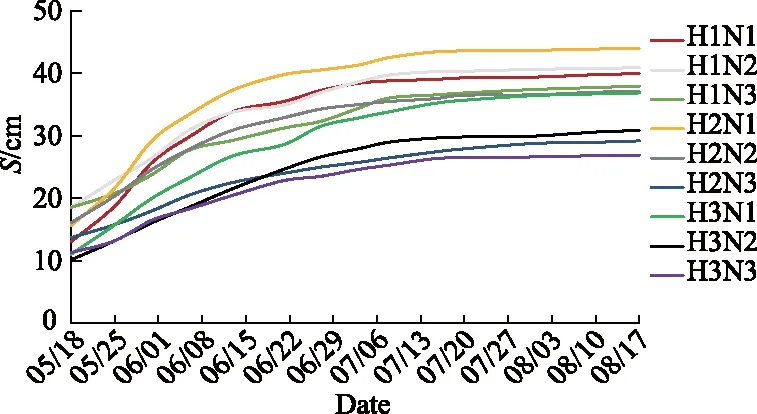
Fig.2 Apple trees length changes with date
Both irrigation level and nitrogen level had a significant effect on the final new shoot lengthS′ of apple trees(Fig.3). When the irrigation amount was H2 and H3, the length of the new shoot increased with the increase of nitrogen application rate, and there was a significant difference between N1 and N3 treatments. Under the same nitrogen level, compared with H3, the new shoot length of H1 and H2 increased by 25.49% and 16.42%, respectively. Under the same irrigation level, compared with N3, the new shoot length of N1 and N2 increased by 28.31% and 15.63%, respec-tively. Compared with H3N3, the new shoot length of other treatments increased by 8.16%-62.92%, and theS′ value of H2N1 treatment increased the most.
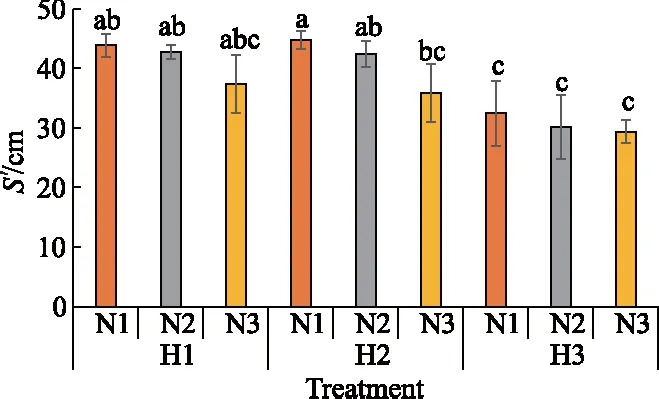
Fig.3 Effect of different water and nitrogen treat-ments on final new shoot length of apple
2.2 Effect of water and nitrogen coupling on LAI of apple trees
It could be seen from Fig.4 that the leaf area indexLAIof apple under different water and nitrogen treatments showed a trend of first increasing and then decreasing during the whole growth period. TheLAIincreased the fastest and reached the peak from mid-May to mid-July. H1N1 and H2N1 treatments reached the peak earlier than other treatments, and the maximum peak of H2N1 treatment was 4.42 m2/m2. There was a significant different in theLAIamong different irrigation levels, and the peak and final values were both H2>H1>H3. Under the same nitrogen level, compared with H3, theLAIof H1 and H2 increased by 30.77% and 67.52%, respectively. Under the same irrigation level, compared with N3, theLAIof N1 and N2 increased by 18.75% and 4.86%, respectively. Compared with H3N3, theLAIof other treatments increased by 21.14%-94.17%, and the peak value of theLAIof the H2N1 treatment was the largest, indicating that the high fertilizer with mild water deficit treatment was more conducive to the growth ofLAI.

Fig.4 Effect of water and nitrogen coupling on LAI
2.3 Effect of water and nitrogen coupling on flo-wering and fruit setting of apple trees
Fig.5 showed the effect of different water and nitrogen coupling on the number of flowering and fruit setting of apple trees, whereFa,Fb,Fcwere flowe-ring,fruit setting and fruit setting rate, respectively. It can be seen from Fig.5 that the irrigation level had a significant effect on the number of flowering and fruit setting of apple trees (P<0.05), and the level of nitrogen application had a very significant effect on the number of flowering and fruit setting of apple trees (P<0.01). Under the same nitrogen level, the number of flowering first increased and then decreased with the increase of irrigation amount, while the number of fruit setting increased with the increase of irrigation amount. Under the same nitrogen level, compared with H3, the flowering number of H1 and H2 increased by 33.15% and 43.45%, the number of fruit setting increased by 28.62% and 27.26%, and the fruit setting rate decreased by 2.78% and 10.07%, respectively. Under the same irrigation level, compared with N3, the flowering number of N1 and N2 increased by 20.92% and 26.17%, and the number of fruit setting increased by 5.19% and 13.74%, but the fruit setting rate decreased by 11.85% and 7.69%, respectively. In all trentments, compared with H3N3, the number of flowering and fruit setting in other treatments increased by 0.71%-58.73% and 12.85%-51.96%, respectively, and the number of flowering and fruit setting in H2N2 treatment was the largest.
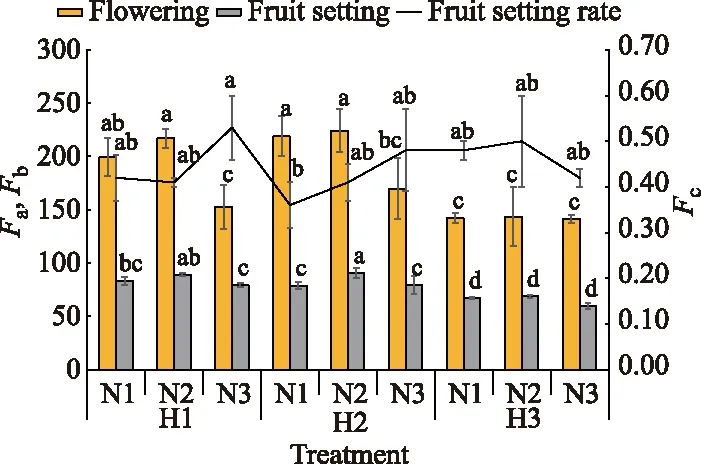
Fig.5 Effect of water and nitrogen coupling on flo-wering and fruit setting
2.4 Effect of water and nitrogen coupling on apple fruit diameter
Fig.6 showed the change curve of the transverse diameter and longitudinal diameters of apples with time under different water and nitrogen treatments.

Fig.6 Effect of water and nitrogen coupling on fruit diameter
It could be seen from the figure that the growth rule of the transverse and longitudinal diameters in different water and nitrogen treatment was basically the same during the whole growth period. The growth rate was relatively slow in the early stage, with the passage of time, the growth rate of the fruit transverse and longitudinal diameters continued to increase, and the growth rate was the largest from mid-June to late August. During the fruit ripening stage, the change of transverse and longitudinal diameter was small and the growth rate was slow.
It could be seen from Tab.2 that irrigation level and nitrogen level had a significant effect on the tran-sverse diameter, longitudinal diameter and volume of apple(P<0.01). Under the same nitrogen level, compared with H3, the transverse diameter of H1 and H2 increased by 3.93% and 3.81%, the longitudinal dia-meter increased by 4.95% and 2.97%, and the volume increased by 12.86% and 11.57%, respectively. Under the same irrigation level, compared with N3, the tran-sverse diameter of N1 and N2 increased by 11.38% and 5.40%, the longitudinal diameter increased by 10.13% and 5.11%, and the volume increased by 36.60% and 17.01%, respectively. In all treatments compared with H3N3, the transverse diameter, longitudinal diameter and volume of other treatments increased by 0.96%-15.29%, 2.30%-15.82% and 4.32%-53.89%, respectively. Among them, the tran-sverse diameter, longitudinal diameter and volume of H2N1 treatment were the largest.

Tab.2 Effect of water and nitrogen coupling on diameter and volume of apple
2.5 Effect of water and nitrogen coupling on apple yield
It could be seen from Fig. 7 that irrigation level and nitrogen level had a significant effect on yield (P<0.05), whereYis the yield of apples. Under the same irrigation level, the yield increased with the increase of nitrogen application rate. Compared with N3, N1 and N2 increased by 17.91% and 12.40%, respectively. Under the same nitrogen level, compared with H3, H1 and H2 increased by 34.65% and 33.67%, respectively. Compared with the H3N3 treatment, the yield of other treatments increased by 2.69%-52.20%, and the yield of H2N1 treatment was the largest, which was 26 852.55 kg/ha.
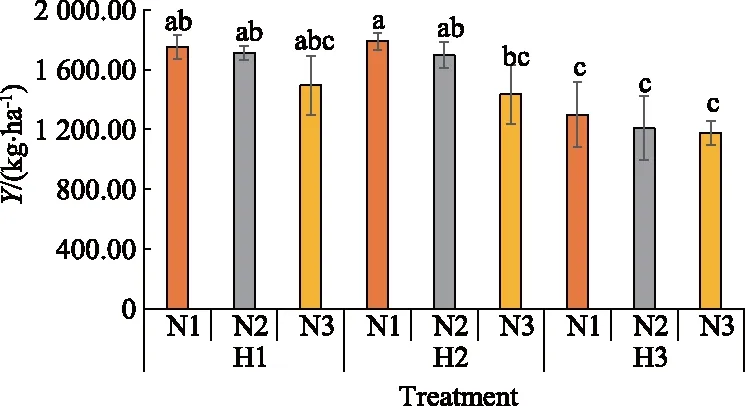
Fig.7 Effect of water and nitrogen coupling on apple yield
3 Discussions
Under the condition of water and fertilizer coupling, the growth of young apple trees was very sensitive to the response of water[13]. The growth of new shoot played an important role in expanding the photosynthetic area, increasing material accumulation, and fruit formation. Reasonable water-fertilizer supply was beneficial to the new shoot growth. TANG et al.[8]found that irrigation amount had a very significant effect on fruit diameter and yield of apple, and it increased with the increase of irrigation amount under the same nitrogen application rate. This study showed that when the treatment was H2N1, the new shoot length of apple trees was the largest. This might be that the appropriate irrigation amount under the SRI would not cause the water and the nutrients in the soil to flow to the deep layer[14], so that the roots of fruit trees could better absorb water and nutrients to promote the growth of new shoot.
This study found that under different irrigation and nitrogen application treatments, theLAIof apple trees showed a trend of first increasing and then decreasing, the peak value appeared in the mid-July. It might be that irrigation and fertilization led to rapid growth of leaves and canopy of trees, which could increasedLAI[15]. The mid-to-late July was the fruit expanding period. A large amount of nutrients and water were used to satisfy the growth and development of the fruit. Reproductive growth was dominant, while the water and nutrients of the leaves were gradually reduced, the tension was reduced, the leaves appeared to wilt in different degrees, and the gap increased between the leaves. Some leaves appeared dry and off, resulting in a drop of theLAI[16]. This study also found differences in theLAIof apple trees between different water and nitrogen treatments. It showed that under moderate water and nitrogen conditions, the mesophyll cells of leaves grow rapidly, which promoted the growth of leaves to increase the maximum expansion rate of theLAI, and thereby increased the maximumLAIand the averageLAI[17].
The level of irrigation and nitrogen application had a significant effect on the flowering and fruit setting of fruit trees. Compared with H3, the flowering and fruit setting of H1 and H2 were significantly increased. It might be that sufficient irrigation water was more conducive to the vegetative growth of fruit trees, thereby promoting the flowering and fruit setting of apple trees. Sufficient nitrogen provided enough nutrients for fruit trees to promote flowering and fruit setting[8]. This was consistent with the results in this study that the number of flowering and fruit setting of N1 and N2 treatments were significantly higher than N3.
This study found that under the same nitrogen level, the volume and yield increased with the increase of irrigation water. This might be that with the increase of irrigation amount, the proportion of soil moisture and air decreased, which enhanced the root activity of the fruit trees, absorbed more nutrients and ultimately increased the yield of apples[18]. Compared with N3, the yield of N1 and N2 increased by 17.19% and 12.49%, respectively, which was consistent with the conclusion of ZHOU et al.[13]that high fertilizer could increase the yield of apple trees. This study found that the H2N1 treatment had the largest yield (26 852.55 kg/ha), indicating that appropriate deficit irrigation and increased nitrogen application were beneficial to increase apple yield[13], but there was no significant difference between N1 and N2 under the same irrigation level. This might be caused by the low soil basic fertility in the experimental area. Increasing application of nitrogen could provide a certain amount of nutrient supply to fruit trees and reduce the effect of water deficit on fruit growth, but whether to maintain this phenomenon after years of fertilization remained to be further studied.
4 Conclusion
1) Under the same irrigation level, the new shoot length,LAI, fruit diameter, fruit volume and yield increased with the increase of nitrogen application rate. Under the same nitrogen level, the new shoot length, fruit diameter, fruit volume and yield increased with the increase of irrigation amount.
2) Compared with the H3N3 treatment, the new shoot length of other treatments increased by 8.16%-62.92%, the transverse diameter increased by 0.96%-12.83%, the longitudinal diameter increased by 14.31%, the volume increased by 4.32%-45.52%, flowering increased by 0.71%-58.73%, fruit setting increased by 12.85%-51.96%, and the yield increased by 2.69%-52.20%. The new shoot length, fruit diameter and yield were the largest in H2N1 treatment.
Therefore, H2N1 treatment was recommended for apple water and nitrogen management in mountainous areas of northern Shaanxi. The results of this study can provide a theoretical basis for water and nitrogen ma-nagement of apples in mountainous areas of northern Shaanxi.

